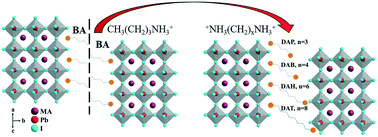Role of alkyl chain length in diaminoalkane linked 2D Ruddlesden–Popper halide perovskites†
Abstract
Alkylammonium cations were widely applied in 2D halide perovskites as bulky spacers to improve their stability, while diaminoalkane molecules containing two –NH2 groups at the heads of the alkyl chains have been rarely investigated. Herein, we report on the synthesis and properties of a new series of 2D Ruddlesden–Popper halide perovskites with diaminoalkane as a bulky spacer, typically, with a compositional formula of (NH3(CH2)xNH3)(CH3NH3)2Pb3I10, and the spacer length effects were systematically studied. As the alkyl chain length increased (x = 3 to 8), the layered structure of the as-made 2D rectangular plates became more complete, and the differences in crystalline structure, light absorbance, band energy position and filming properties became evident. In particular, (DAT)(MA)2Pb3I10 (x = 8, abbr. as DAT) with a pure chemical composition was synthesized and showed excellent 2D characteristic properties compared with well-studied (CH3(CH2)3NH3)2(MA)2Pb3I10 (abbr. as BA). A crystal growth mechanism including “layered” and “stepped” growth was originally proposed to elucidate the orientation and morphology difference between 2D DAT and BA perovskites. Moreover, the deposited DAT film showed outstanding film characteristics, including a facile fabrication method and an ultralow surface roughness of 2.97 nm. Furthermore, we have successfully implemented this new 2D perovskite in solar cells, and obtained an inspiring power conversion efficiency.



 Please wait while we load your content...
Please wait while we load your content...